Combination boilers for home heating: types, description of operating principle + selection tips
When heating private households or country cottages, combined boilers are often used to heat the house - they will ensure a comfortable temperature in all rooms, regardless of the presence or absence of a centralized gas supply or firewood.
A significant advantage of such units is the adjustment of cost estimates not only for heating the building, but also for supplying hot water. Besides, it’s very convenient to be able to use different types of fuel, don’t you agree?
The efficiency of combined boilers in the absence of access to a central energy supply system is confirmed by numerous reviews from their owners. The main task is to choose the optimal type of heating unit.
We will help you make the right choice. The article describes the features of operation, operation and maintenance of different types of combined boilers. We have outlined the main criteria for evaluating equipment and provided practical recommendations for choosing a heating unit.
The content of the article:
Main types of combined boilers
Combined type heating equipment is focused on loading and processing two or more types of fuel materials.
More than 70% of the models on the market are equipped with special electric heaters, which help to partially or completely eliminate the use of the main heating elements for heating water in the summer season.
The type of fuel material used allows us to roughly divide the equipment into 2 main groups:
- standard – use no more than two different types of fuel;
- universal – capable of operating on three or more fuel options.
In most cases, it is possible to replace the burner in order to change the fuel supply function. There are also models on sale equipped with hobs and even two burners with electronic or electromechanical control.
There is only one catch here - the more expanded the functionality of such a unit, the more difficult the installation process will be.
Owners of country houses whose heating is provided by a combined heating boiler unanimously declare its undeniable advantage. Especially if the house is located far from large populated areas, and the lack of gas supply and frequent power outages are the norm in this area.
In addition, a combination boiler, also called a universal boiler, has many other advantages.
They allow you to compete with the most popular types of one-component systems:
- possibility of connecting several circuits;
- a wide range of resources for technical modernization - burner replacement, boiler installation;
- modern level of program management;
- no interruptions in the heating system - when the supply of one type of fuel stops, it is possible to use an alternative option;
- economical expenditure of funds on the provision of a heating system.
Models with electromechanical control will become simply indispensable in homes located in areas that often experience power outages.
This option allows, if necessary, to transfer the boiler installation to manual adjustment mode without losing the productivity of its operation.
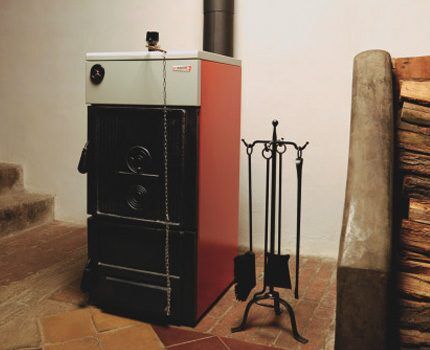
Popular fuel combination options
Various variations of combined heating units make it possible to solve various types of problems - from large-scale to less global problems. For example, they are capable of providing hot water supply to both a single family of 3-5 people, as well as heating an office building or residential apartment building.
Option #1 – gas/electricity combination
Electricity is the most efficient way to heat water. A rapid increase in temperature is achieved due to the effect on the coolant, with the least amount of delay.
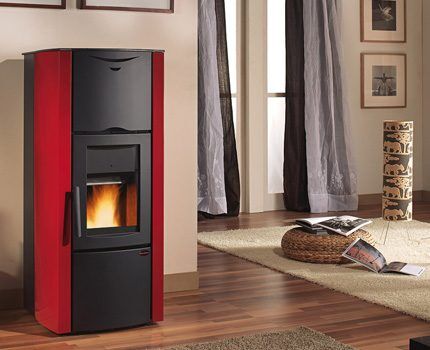
Characteristics of combined heating devices that provide significant advantages:
- Small sizes. The device has an oversized combustion chamber for combustion of gases, a heat exchanger with a built-in heating element or other type of heating device;
- Low power consumption. The boiler operates on gas, and the electric heater is put into operation only on demand - to quickly heat water or in the absence of access to a gas supply;
- Low price category. This is achieved due to the absence of a separate combustion chamber - the heater is installed inside the heat exchanger. In equipment where there is no secondary circuit, the option of connecting a water heater is planned;
- Heating elements with low power – many models on the market are designed only to support the specified temperature.
Although gas is an economical type of fuel, the same cannot be said about electricity. Therefore, for houses located in areas with a poorly developed gas supply network, you should consider another boiler option that runs on a different fuel.
Option #2 – wood/gas combination
Gas and wood are considered more economical types of fuel. The dimensions of the heating apparatus operating on such fuel are impressive - it has separate combustion chambers for each type of fuel.
The design features of boilers with a combination of gas/wood type determine the placement of one or two heat exchangers. For the first case, it serves as a common element for all combustion chambers.
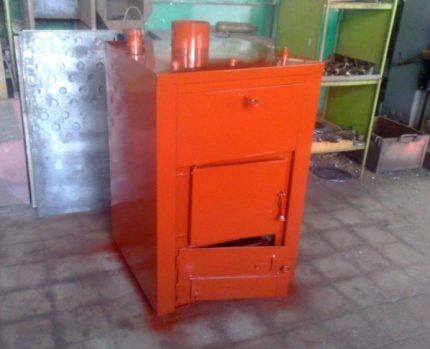
IN double-circuit boiler Only one type of fuel is used to provide hot water supply. This type of combined boilers requires preliminary registration of permitting documentation for installation.
In addition, these boilers are divided into two more subtypes: with a common and separate combustion chamber.The first option applies to installations created independently. They are used to minimize the final cost of providing the heating system of a country house.
You can install a gas burner in a classic boiler model with your own hands, but if solid fuel is used, it is dismantled. This option creates unacceptable operating conditions for the heat exchanger - exposure to high temperatures during burner operation. This is a common cause of boiler malfunction.
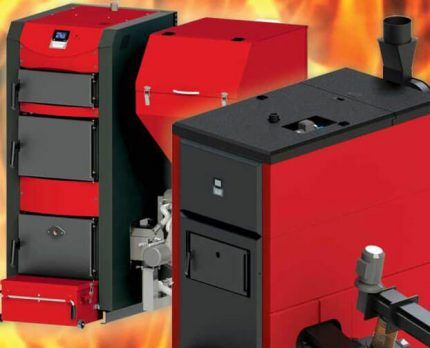
The design with separate combustion chambers is equipped with a dual-circuit system, one of which is used to heat water for heating, and the other to provide hot water supply.
In the case of converting a solid fuel boiler to use diesel fuel, only forced-air burners are installed:
Converting solid fuel heating equipment to a liquid version will reduce costs without losing performance. This solution is advisable if switching to the use of main gas is not yet possible. Still, heating with diesel is 2-3 times more expensive than with gas.
Option #3 – wood/electricity combination
If it is impossible to connect to the main gas supply or arrange heating with cylinders, they most often use solid fuel boilers. They have great power and are energy independent.
Structurally, combined wood/electricity boilers are quite similar to gas models. Independent production of this type of device is also available. It will be enough to determine the required power, select heating element and install it into the heat exchanger.
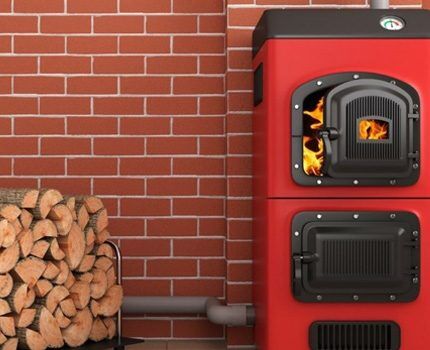
In addition to these characteristics, it is necessary to note the following features of combined heating boilers operating on wood and electricity:
- auxiliary capabilities – connecting the heating element unit through the contact zone with a thermostat or a special software unit that provides remote control of the boiler operation;
- increased resistance to breakage – factory ones provide heat supply through the operation of heating elements (heating elements) that can withstand the high thermal impact during operation of the combustion compartment;
- maintainability – if the electrical part of the boiler fails, it can be easily replaced. In many models of gas heat generating units, this function is not available.
The power of a solid fuel boiler is regulated relatively slowly. Due to this feature, to quickly adjust the heating level, manufacturers recommend using the electronic part of the heating system.
Option #4 – multi-fuel installations
The design features of multi-fuel heating equipment for domestic use are based on the use of several alternative fuels. Such heating systems include models with a combination of pellet pellets/gas/wood/electricity.
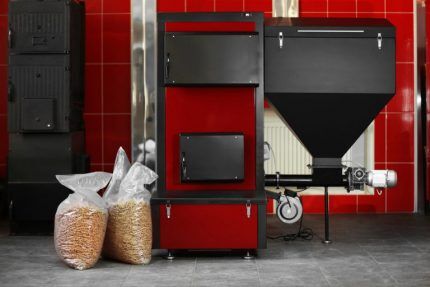
The most significant design feature of pellet combined heating boilers is the equipment with several combustion chambers adapted to use one type of fuel - solid or liquid.
In addition to the functionality, it is possible to install an electric heating element located in the heat exchanger chamber.
Due to the easily removable pellet burner, it becomes possible to use other types of fuel, for example, diesel or gas.
To use this kind of energy carriers, conditions are necessary to create a forced draft pressure and certain design features of the heat exchanger. All these characteristics are characteristic pellet boilers.
A multi-fuel heating system can only be installed after the following requirements are met:
- Uninterrupted power supply – a necessary condition for activating the operation of a pellet heating boiler, gas and diesel burners (the use of solid fuel materials is an exception);
- Organized supply of fuel materials to the boiler - this is the most acute problem when designing the installation of heating boilers with a combination of gas/wood/electricity;
- Providing energy storage space – for the use of balloon heating, external steel boxes are installed or a separate room, and in some cases a building, is allocated; Diesel is stored in tanks connected to the pumping unit.
Before purchasing universal heating equipment, it is necessary to analyze the main factors influencing the choice of a specific model.
Thus, the feasibility of using each type of energy carrier, because the cost of such a device is much higher than single-fuel systems.
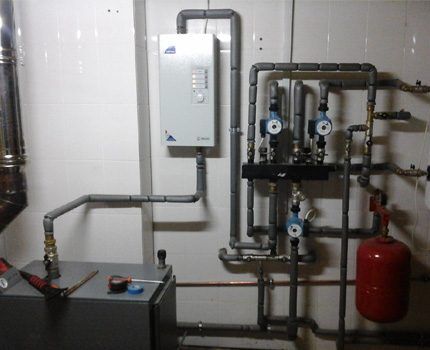
How to choose the right boiler?
The only objective criterion for choosing a combination boiler for your home is the required power to ensure the functioning of the heating system. Moreover, this indicator should not be affected by the number of connected circuits.
It makes no sense to pay more for a powerful boiler in the hope that its operation will be adjusted automatically. This approach promotes “idle” operation of the device, which leads to faster failure.In addition, this operating mode helps accelerate the condensation process.
As for calculating power, theoretically, to heat an area of 10 m2, you will need to use 1 kW of heat energy.
But this is a rather conditional indicator, which is adjusted based on the following parameters:
- ceiling heights in the house;
- number of floors;
- degree of insulation of the building.
Therefore, it is advisable to use a factor of one and a half in your calculations, i.e. In calculations, increase the reserve by 0.5 kW. The power of a multi-circuit heating system is calculated with an increase of 25-30%.
So, to heat a building with an area of 100 m2, a power of 10-15 kW will be required for single-circuit heating of the coolant and 15-20 kW for double-circuit heating.

An equally important criterion when choosing a combined heating boiler is the price category. The price of the device depends on the power, number of functions and manufacturer.
Other characteristics are no less important for users:
- DHW;
- material of manufacture;
- ease of use;
- dimensions;
- components;
- weight and installation features;
- other.
The issue with hot water supply must immediately be resolved: will the boiler provide the supply of hot water or is there a electric boiler.
If the first option is determined, the more preferable method is selected - storage or flow-through, as well as the parameters of the water tank according to needs (calculated based on the number of residents).
As for the size of the equipment, they are important only in the case of installation in a room with a small area.
There is a wide range of boilers based on the material used. But the most popular options are steel or cast iron. Also, such a boiler is able to withstand high and prolonged temperature loads and has a longer service life.
Judging by the intensity of sales and relying on consumer reviews, the following models are actively in demand:
Automation of control affects ease of use, and the safety system also depends on how automated the energy combustion process is. Most models can be controlled using convenient remote controls or panels.
Most models have additional equipment. This may include the presence of a hob for cooking, injectors, draft regulators, burners, soundproof casing, etc.
You should choose a boiler based on this parameter depending on personal preferences and the allocated amount for the purchase.
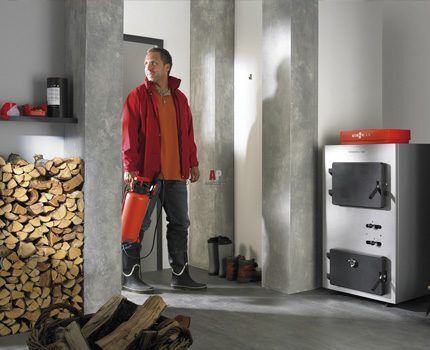
But you should immediately pay attention to the weight of the equipment and the complexity of its installation.
Installation in a residential building of most floor-standing models of combined heating boilers, equipped with several combustion chambers, requires an additional installation of a concrete pedestal, because the standard floor covering will not be able to withstand such a load. Optimal solution - install a separate boiler room.
Knowing the main parameters that influence the choice of a combination boiler, you can choose the most suitable model.
Additional recommendations for selection, as well as a comparative overview of different heating units for a private home, are given in this article.
Conclusions and useful video on the topic
The operating principle of universal heating equipment in the video:
Rules for choosing a combination boiler in the video:
An example of the operation of a pellet combi heating boiler:
Regardless of the selected type of equipment, before purchasing it, it is necessary to design the future heat supply system. This includes: pipelines, chimney duct and safety measures when operating the heating device.
This will ensure complete functioning systems heating at minimum costs on energy resources.
Looking for an efficient combi boiler for your home? Or do you have experience using such installations? Please leave comments on the article, participate in discussions and share your impressions about the use of heating units.
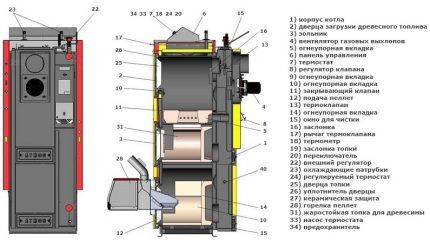




I have a dacha outside the city; we rarely go there in winter, mostly only for the New Year holidays. But even with such a visit, you want the house to be warm. I decided to install a combination boiler in combination of gas + electricity. It seems to me that this is the best option for a summer residence. Heats up quickly, does not require much electricity, and the price is low. And it is also small in size, it can be placed even in a small room.
Combination boilers are a good option for a private home. It is not always possible to connect to a gas supply.We bought a house in the village, it was very profitable, but gas definitely won’t be available there for the next year, and a combination boiler like this is like a salvation. We took a universal one, it is of course more expensive, but it can also run on different fuels. Now you can even choose a design that is more or less suitable.
Roman, is it worth spending money on a multi-fuel one if there will still be gas in the future? Even if it’s a year later. In general, I recommend in such cases, while gas is expected, to take something cheap. And then, a good gas boiler. Without any firewood or versatility.
Egor, it’s really worth spending money and buying a combination boiler, especially in this case. A person now needs to heat his house with something, but gas will be available in a year, this is what is planned, and maybe it will take more time. A gas/electric combination is the best option.
Firstly, the heating system will already be connected to the boiler; when the gas is connected, there is no need to change the wiring, piping, or resolve the issue with heating pipes - everything is already ready!
Secondly, if problems suddenly arise with gas, you can always switch to electricity and vice versa.
In addition, electricity tariffs in the village are more affordable than in cities, so it will not greatly affect the family budget. I recommend immediately installing a two-zone electricity meter, day/night. Plus, make a paper stating that the heating is based on electricity in order to receive a discount for the heating season.
I have a house in the village of about 200 sq.m., I want to use a boiler for heating. We don’t have a main line, and I’m wary of gas, so I was leaning toward combined electricity/wood.But my father-in-law dissuades me, he says that combined boilers are ineffective and it’s better to buy two separate ones. Has anyone used boilers of this combination? And if possible, recommend a specific boiler model.
Let me ask you what is the inefficiency of a combination boiler? What are the arguments of a person who advises buying two separate boilers? I'm just curious to know about it :)
As for the combi boiler, this is an excellent solution, especially for your conditions. Your house is 200 sq. m., therefore, based on the required power, I can recommend the following models:
— Maxiterm Lux Nowa 26, price $770;
— Tehni-x KOTV-22-U, price 420 dollars.
I chose such a wide range of prices because I don’t know what budget you are counting on. Combined - this is one piping, installation is much simpler when compared with two separate boilers. You can also use wood/coal and electricity at the same time: raise the temperature using wood and then maintain it from the mains. If you have any more questions, ask here.
Hello. I want to buy a combined wood/electricity boiler for 70 m2. Which one would you recommend? To the dacha
Good afternoon.
The article is very informative, but I still have a question. We built a house, now we are thinking about heating. Gas is planned throughout the year. House area 160 sq.m. Please advise whether it is possible to use an electric/gas combination boiler for constant heating of the house in winter with electricity, then switch it to gas?
And what kind of boiler is this: model, brand... I didn’t find any
Good afternoon Please tell me which boiler is better to choose? Initial: apartment in an apartment building 45 m2, the boiler is needed only for heating, gas in the future, and even then, most likely, I will not do it, because it is too expensive. Now the heating is through a makeshift wood stove, i.e. There is something like a chimney. I would like the ability to switch from wood to electricity and automatic control of pressure, temperature, water supply, shutdown. And it should also be compact.
I live in a special cabin in the village. Today I plan to replace the gas boiler with a combination (gas-wood) boiler. Area 55 sq.m. Dimovivd. There is no need to heat the water. It’s a boiler. Help select.